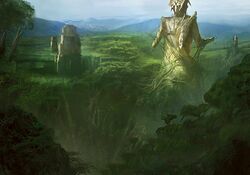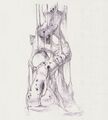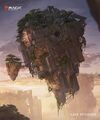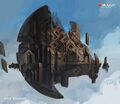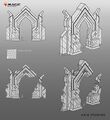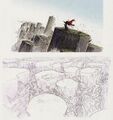Murasa
| Murasa | |
|---|---|
| The Walled Continent | |
| Information | |
| Plane | Zendikar |
| Formerly part of | Makindi Empire |
| Scryfall Statistics | |
|
43 artworks | |
Murasa a.k.a. The Walled Continent is one of the seven continents of Zendikar.
Description
Murasa is a vast, steep-walled plateau that rises sharply from the sea. It is smaller than the other continents of Zendikar. Behind its outer cliffs, the land drops in elevation and is dominated by hills and deep, jungle-filled valleys. Several highland areas are, however, also present.[1] It is said to be impossible to sail past the continent of Murasa, as travelers attempting to pass the island are inexplicably drawn to its shores.[2]
Murasa is home to a series of immense flora, including the massive, multi-trunked harabaz trees, whose entwined roots join to form one titanic organism. The trees grow blade-shaped prows that break waves from reaching the shore and also deter ships from landing in Sunder Bay.[2] It also hosts jurworrel trees, whose thorns leak a thick green sap that can knock creatures unconscious. Jurworrels possess a mean intelligence, but they can move only by growing, which they do very slowly. Kazandu is known to house jaddi trees, towering trees that continuously grow and never die.[1]
History
Murasa was once part of the ancient Makindi Empire. The Makindi reign ended when an enormous sea monster — perhaps an ancestor of Lorthos, the Tidemaker, or maybe Lorthos itself — dragged the Murasa Skyclave into the sea.[3]
Notable locations
- Glint Pass - a huge sea cave leading under the east side of Murasa's Wall. The caverns gained their name from the light given off by flame-quartz, clusters of crystals found throughout much of the underground passage. At its rear lies a cavern opening accessible when the tide is low, which can provide passage into the interior of Murasa if crossed before the tide rises again. Vampire guides often provide safe passage to the inland.[1]
- The Cipher in Flames
- an ever-burning and complex glyph set in the heart of the rock of the pass. It is said that those who can decipher the glyph can be teleported to anywhere on the plane, though none have yet succeeded.[1] The glyph is one of six sites known to be pre-Eldrazi, meaning it was created before -1400 AR.[4]
- Visimal, the Hidden City - an ancient structure of diamond-shaped passages on the far side of Murasa's Wall, where vampires have lived for as long as any can remember.[1]
- The Cipher in Flames
- Kazandu
- a vast, collapsed region, shaped by an ancient cataclysm into a maze of canyons, valleys, and towering plateaus. Its shadowy lowlands are dominated by immense, ageless jaddi trees, whose dense canopy shelters secluded elf splinters and entire ecosystems high above the forest floor.[1]
- The Living Spire, or the Howling Spire
- a natural rock pillar in Kazandu, honeycombed with caverns that are not all of natural origin. Strong winds cause the spire to whistle and moan as they sweep past and through these caves, lending an eerie aura to the place that befits the strange statue at the top of the pillar. The statue depicts Talib, the kor god of the earth, who glares balefully down from on high at the jungles below. Jurworrel trees and bloodbriars clutch at the statue as if intent on tearing it down, but despite the wear of the ages, the statue still stands mostly intact.[1][5]
- The Grindstone Crucible - titanic hovering vines spiral through the caverns to a great chamber at the pillar’s heart. There, a thundering mass of huge, rune-covered boulders and shards of rock grind together in a constant rumble, encompassed in a spherical latticework of vines. This is a post-Eldrazi ruin, meaning it was made after about -1400 AR.[4] This strange place is a font of wild mana, but to draw on its strength, one must stand on the vine lattice or between it and the Crucible. But when winds howl into the chamber, they are drawn into the Grindstone Crucible with hurricane force, taking pieces of the latticework with them and potentially drawing a nearby creature into the grinding stone to certain death. When the winds are still, the vines grow, thrash, and writhe, struggling to encompass the Crucible before its next great inhalation.[1]
- The Raimunza River
- flows from the base of the Na Plateau and into Kazandu, where it falls upon the branch of a jaddi tree that grew beneath it. The river flows across miles of the trees' branches, often cascading off one branch before being caught on another.
- Blackbloom Lake
- The river eventually falls into this lake in the center of Kazandu.[1]
- Blackbloom Lake
- Root caves
- large, cavernous gaps extending beneath the roots of the jaddi trees. Three such caves are known to exist:[1]
- The Doom Maw
- the dominion of demons and bone-hoarding dragons.[1]
- The Silent Gap
- plumbed by a group of vampires that seek some secret beneath the earth.[1]
- A third cave
- not named and is home to migratory populations of three dangerous animal species, caustic crawlers, giant bats, and shadow scorpions, which inhabit it at different times.[1]
- The Doom Maw
- The Living Spire, or the Howling Spire
- The Murasa Skyclave
- a floating ruin of an ancient fortress, once toppled by Lorthos or one of his ancestors. Risen from the sea again, it is partially flooded and was quickly covered in dense foliage.[3]
- The Murasa Wall
- the towering cliffs surrounding the continent. Inland from these cliffs, the land drops off sharply.[1]
- The Cliffs of Kazuul
- controlled by Kazuul, an ogre slavemaster who demands tribute from those seeking to use the log-and-rope elevators to enter the continent.[1][6][2]
- Kazuul's Mines
- in addition to the passage up the cliffs, Kazuul claims ownership of a network of mines inside Murasa’s Wall, dug from the inland side of the mountains. His agents bring slaves of all races, purchased from North Hada or Zulaport, to toil in the mines and carry ore to sell in Sea Gate and Kabira.[5]
- The Kazuul Road - the only cliff-side ascent that allows access into Murasa. Built by elves and maintained mainly by humans.[1]
- Kazuul's Mines
- The Cliffs of Kazuul
- The Na Plateau
- east of Murasa's center, is a quarter mile high. Its cliffs are home to wurms that range into the surrounding plains to hunt, while the plateau proper is home to goblin tribes.[1] It is known for its many-armed, gargantuan statues.[2] It was the location of the Singing City, a pre-Eldrazi[4] kor-built maze named for its maddening sounds.[1][7] It was destroyed when Nissa used the Lithoform Core.[8]
- Raimunza Falls
- a raging torrent of water that cascades off the southern side of the Na Plateau.[1]
- Raimunza Hive - a human and elvish ore-mining operation surrounding the Falls. The cliffsides around the falls are honeycombed with passages drilled by miners, which are often overtaken by swarms of jagwasps seeking to use them as nesting spaces. Although the adult wasps are dangerous, their larvae help the miners by burrowing through the rock with their acidic slime.[1][5]
- Raimunza Falls
- The Pillar Plains
- an area where Murasa's Wall is broken into thousands of massive pillars, the tops of which are grassy plains. The plains were historically home to clans of kor herders, but in 4537, they were all massacred, their bodies hung from their hooks, dangling over Thunder Gap. The pillar plains are now home only to their feral oxen.[1][5]
- The Vazi River
- splits many times as it passes through the Pillar Plains, but these side channels typically rejoin with the river in crashing waterfalls. Its waters are difficult but navigable for a few miles inward from the ocean, but then most of its length consists of thundering rapids supplemented by roaring waterfalls.[1]
- Thunder Gap - a passage into the continent following the route of the Vazi River as it heads out to sea. Boats can navigate the dangerous rapids for a couple of miles inland through the canyon, but travelers must then disembark and take the precarious trails and rope bridges further inland.[2] Once the safest route to Murasa's interior, after the mysterious kor massacre in 4537 AR, the trail has been considered haunted and left unmaintained.[1]
- The Wall of Omens[1]
- The Vazi River
- The Skyfang Mountains
- high, steep-sided mountains covered in forests. They begin from the western side of the Wall and extend deep into the interior, cutting the western part of the continent in two. The mountains are home to dangerous animals and are marked by the Fangs, large shards of rock that float in midair when in the sunlight but crash to earth at night and when clouds cover the sun.[1]
- Shatterskull Pass
- a wide trail passing through on a relatively shallow incline. While this is the safest part of the mountains to cross on foot, travel through the pass is made dangerous by the numerous Fangs hanging above it and by the presence of rocs, giants, and minotaurs.[1]
- Zektar Shrine
- an elemental-infested shrine in the black-rock Shatterskull Mountains.[9]
- Shatterskull Pass
- Sunder Bay or Sunder Cove
[10] - a huge bay full of submerged harabaz trees whose seaward sides grow into large blades that split waves that would otherwise crash against the trees.[2] This is the largest break in Murasa's coastal cliffs and an important route into the continent, despite the danger posed by the trees. Elves of the Tajuru tribes and assisting merfolk have set up a network of flags and beacons to mark the safest route.[1]
- The Tumbled Palace
- capital of the Tajuru elves, perched on the cliffs of Sunder Bay.[10] It stands above a massive jurworrel tree that has spent centuries trying to push the palace into Sunder Bay. Jurworrel trees, which grow on cliffs and rocky outcroppings across Murasa, are known for their dark, thorny branches that leak a thick green sap capable of knocking creatures unconscious. These trees possess a measure of intelligence but can only move by slowly altering the direction of their growth. The jurworrel beneath the Tumbled Palace seems determined to rid itself of the structure — an effort the elves do not fully understand. In truth, the palace harbors remnants of Eldrazi corruption, which may have influenced its past speakers and is likely the cause of Nisede’s deep mistrust of the place. While the jurworrel attempts to purge this lingering corruption, the palace’s ancient magic resists it.[1][5]
- The Tumbled Palace
Gallery
-
Jaddi tree concept art.
-
Kazandu Refuge
-
Kazandu Valley
-
Murasa Skyclave section concept art by Sebastien Hue.
-
Murasa Skyclave section concept art by Sebastien Hue.
-
Murasa Skyclave interior concepts by Sebastien Hue.
-
Nahiri reaches the Murasa Skyclave.
-
Nahiri and Zareth San explore the Murasa Skyclave.
-
Nahiri and Zareth San explore the Murasa Skyclave.
-
Nahiri enters the Lithoform chamber.
-
Pillar Plains concept art.
In-game references
- Represented in:
- Associated cards:
- Referred to:
References
- ↑ a b c d e f g h i j k l m n o p q r s t u v w x y z aa ab Magic Creative Team (February 24, 2010). "A Planeswalker's Guide to Zendikar: Murasa and Sejiri". magicthegathering.com. Wizards of the Coast. Archived from the original on 2020-11-26.
- ↑ a b c d e f Magic Creative Team (January 27, 2010). "The Tyrant of the Cliffs". magicthegathering.com. Wizards of the Coast. Archived from the original on 2021-04-29.
- ↑ a b Ari Zirulnik and James Wyatt (September 1, 2020). "Zendikar: Things Have Changed". magicthegathering.com. Wizards of the Coast.
- ↑ a b c James Wyatt (April 2016) - Plane Shift: Zendikar, WotC.
- ↑ a b c d e James Wyatt (January 5, 2016) - The Art of Magic: The Gathering - Zendikar, WotC.
- ↑ Magic Creative Team (September 9, 2009). "A Planeswalker's Guide to Zendikar". magicthegathering.com. Wizards of the Coast. Archived from the original on 2020-10-31.
- ↑ A. T. Greenblatt (September 23, 2020). "Episode 4: Of Haunting Songs and Whispered Warnings". magicthegathering.com. Wizards of the Coast.
- ↑ A. T. Greenblatt (September 30, 2020). "Eoisode 5: The Two Guardians". magicthegathering.com. Wizards of the Coast.
- ↑ Doug Beyer (October 7, 2009). "The Moment of Discovery". magicthegathering.com. Wizards of the Coast. Archived from the original on 2021-01-22.
- ↑ a b Magic Creative Team (September 30, 2009). "A Planeswalker's Guide to Zendikar: Bala Ged and Elves". magicthegathering.com. Wizards of the Coast. Archived from the original on 2019-08-12.
Sources
- Doug Beyer (September 02, 2009). "The Planes of Planechase". magicthegathering.com. Wizards of the Coast. Archived from the original on 2019-03-01.
- Doug Beyer (January 27, 2010). "The Tyrant of the Cliffs". magicthegathering.com. Wizards of the Coast. Archived from the original on 2021-04-29.
- Magic Creative Team (January 27, 2010). "A Planeswalker's Guide to Zendikar: Murasa and Sejiri". magicthegathering.com. Wizards of the Coast. Archived from the original on 2020-11-26.
